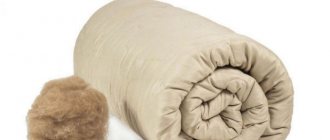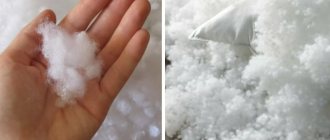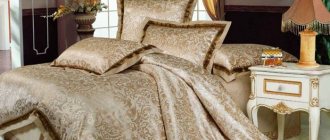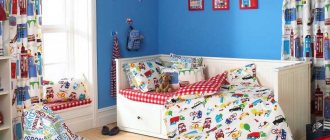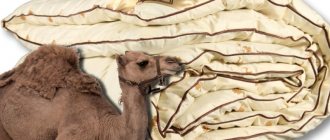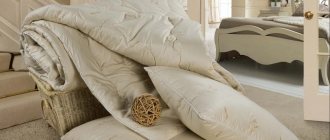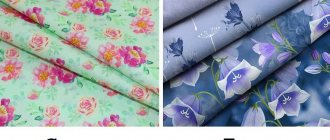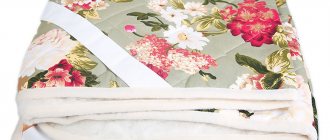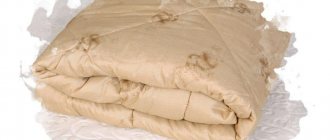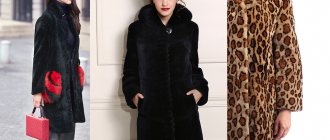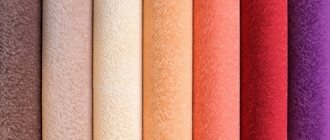A healthy, sound sleep is a guarantee of vigor and good mood the next day. To make it comfortable, look at the quality of the bedding and what the blanket is made of. You need to find that balance so as not to overheat and freeze under it in different temperature conditions. A silk blanket is a universal product in this regard! It will make your holiday enjoyable. Even under the winter version it will not be hot in the summer. Pros and cons, manufacturers, silk varieties, how to care - useful information for those who are interested in this valuable product.
What is it and who is it suitable for?
Silk is a soft and durable thread that comes from the cocoon of a caterpillar. This fiber is used for filler, which consists of many layers superimposed on each other. As a result, a lush and elastic “net” is formed.
A silk blanket is suitable for any person. There are medical recommendations to use this material for patients suffering from asthma or arthritis.
It has been proven that the material has a positive effect on the regeneration of the body. Therefore, it is not only harmless, but also beneficial for babies.
How to choose a silk blanket
Fibers of an expensive variety will be elastic and soft to the touch. The color of silk cannot be perfectly white; in most cases it is slightly beige or cream with a pearl sheen.
The best blankets to buy are the ones that are not quilted. A sewing needle leaves holes from which silk can escape, which can deteriorate not only the appearance of the product, but also its quality.
If possible, you can ask the store clerk to pull out and set fire to a thread of silk. If your fingers get dirty from the coals, and the smell is similar to the smell of burning organic substances (hair, wool or nails), then we can confidently say that the product is natural.
Types and features
The type of silk determines the cost, service life, and quality of the textile.
The most expensive and natural is Mulberry silk. It is produced from the cocoon of a silkworm raised in captivity, which feeds exclusively on mulberry leaves.
The color of the threads is not snow-white, but more creamy or pearly, obtained by refusing to use chemical reagents. The absence of a bleaching step preserves the natural properties of silk thread, namely softness and elasticity.
Tussa silk is considered more economical. It is produced from the cocoons of a free-living caterpillar whose daily diet includes tree leaves. As a result, the threads turn out to be stiff, yellow or brown.
To make the fibers lighter, they are softened and bleached using chemical compounds. This process affects the quality of the silk thread, which significantly reduces the price of the final product.
The Tussa variety is an option for a budget purchase.
Origin and characteristics of silk
This delicate and at the same time durable material is made by the silkworm caterpillar. To make a cocoon for itself, the larva produces a protein called fibroin, which hardens in air. She wraps herself in a continuous thread, up to 1000 m long, and glues it together using the protein sericin (they try to remove it during production). Living conditions and what the caterpillar eats affect the type of silk thread. Its thickness is about 30-32 microns, and the shape of the prism refracts light, so the fabric gives beautiful shimmer.
Natural silk fiber is not so easy to obtain. This is a intensive multi-stage production. At the first stage, silkworm cocoons are obtained. The caterpillars are fed, healthy ones are selected, which are then twisted into cocoons. They are given mulberry (mulberry) leaves as food. Then the cocoons are sorted and untwisted, after killing the pupa (otherwise it will turn into a moth and damage the cocoon). To make silk thread for yarn, you need to twist about five thin threads made by a silkworm. This is how raw silk fibers are formed, which, after processing and re-twisting, are supplied to fabric factories.
Flaws
There are plenty of significant disadvantages to natural fiber blankets.
- Price. The composition and labor-intensive production process affect the final cost.
- Possibility of counterfeit. Some suppliers present a 100% composition as a mixture of natural threads with added impurities.
- Difficult to operate. If used incorrectly and washed, it quickly loses its appearance.
Advantages and disadvantages
According to many modern people, silk bedding is the best sleep accessory. Silk blankets and pillows have been used for several hundred years in the bedrooms of the nobility.
Silk blanket
They have a number of undeniable advantages:
- lightness - silk thread has a tubular shape with a smooth surface, and is characterized by extraordinary softness and airiness;
- “breathable” effect - such blankets maintain a comfortable microclimate for the body all night long;
- hygroscopicity - remain clean for a long time, do not accumulate static electricity;
- durability - strong silkworm thread allows you to preserve rare qualities and a pleasant appearance for up to 20 years;
- lends itself well to draping - folds and waves can be laid easily, giving elegance and weightlessness to the products.
- Color fastness - does not fade or stain during washing. The color of the material remains like new for a long time.
Pros and cons of a silk blanket
Natural silk, of course, has its disadvantages:
- wrinkles a lot;
- does not tolerate moisture - when drops of water or sweat come into contact with it, stains remain on the material;
- capricious and demanding in care - delicate flowing fabric does not like ironing or washing;
- susceptible to moth attack.
Important! The disadvantages of silk blankets are their high cost and excessive thermal conductivity, which makes them not the best option for winter.
Rules of use and care
In order for a silk blanket to last as long as possible, it is better to follow simple rules:
- Once every six months, ventilate, dry and shake it so that the filler regains its original shape and becomes airy;
- If sweat stains appear, remove them with alcohol;
- Use dry cleaning for cleaning;
- store only in a dry place.
Absolutely forbidden:
- wash in an automatic machine;
- keep in vacuum packaging;
- use the product without a duvet cover;
- expose to direct sunlight when drying or airing.
Proper care and use of such an expensive and delicate item as a blanket with silk filling will ensure a comfortable and healthy sleep.
Good to know
- China is the birthplace of sericulture and the leader among producing countries (up to 80% of world supplies). It has been made there for about 5,000 years. Back in the 2nd century BC. e. The Great Silk Road was built, from where Chinese silks were transported to Europe. The production itself was kept in the strictest confidence, the disclosure of which was punishable by execution. The Byzantine Emperor Justinian managed to find out the secret according to one of the legends in the 6th century. He was helped by Persian monks, who were able to hide and carry out several silkworm eggs in a bamboo stick.
- It takes about three thousand cocoons to make half a kilogram of silk. A silk blanket will require four times as much.
- The strength of the material is so high that body armor was made from it a little more than a century ago. But washing with chemicals can dissolve the material, because its basis is natural protein.
- Cocoons are used to cleanse the face and do peeling. Sericin will reduce irritation and pigmentation, and fibroin tightens pores.
- For Muslims, silk is women's clothing and is prohibited for men. And in the East, men treated impotence with this fabric using silk underwear. In the Russian Empire, during military operations, a decree was issued requiring all officers to wear silk underwear. The reason is the spread of lice. No parasite can live in such tissue.
- A burning test distinguishes a natural product from a fake: set fire to a couple of threads and rub the ashes. Synthetics melt and smell pungent, while silk smells like wool and leaves a charcoal residue.
- Silk is practically not electrified. A scarf made of this material will not ruin your hairstyle. Static electricity creates inconvenience and attracts dust and germs.
- The silkworm is completely domesticated and is no longer found in its natural habitat. Its females have lost the ability to fly. American scientists are working on genetic modification of the species and have bred an insect that produces a very strong thread. In Japan, a modified silkworm has been created that produces luminous threads.
Recommendations for selection
Any case must have a zipper. By unfastening it, you can examine the contents.
- The filler consists of a homogeneous layer, without compactions or lumps. Its porous layer quickly restores its original shape even with slight deformation.
- The thread is very strong, you will hardly be able to break it. When set on fire, there will be a smell of burning organic matter.
- A silk blanket has a specific aroma that will disappear after some time.
- It is recommended to choose a blanket with a non-quilted fabric so as not to spoil the structure of the layers.
The main recommendation is to purchase certified products only from reputable suppliers.
Blanket with silk filling: Reviews
On the Internet you can find mostly positive reviews. Most buyers are satisfied with their purchase and are now not ready to exchange their silk blanket for anything else. They write that it is important to follow the rules of care so that the item remains neat; they advise you to contact only trusted sellers so as not to stumble upon a fake.
Manufacturers
There are well-known manufacturers on the world market who use proven and licensed raw materials.
OnSilk
One of the largest factories in Russia. The company sells home textiles made from noble fabrics.
Togas
An international factory that has been creating high-quality textiles for over 100 years. Stores of this company are open in major cities around the world.
Aonasi
The products of this factory meet all quality standards. For the filler, only the Mulberry variety is used, and the covers are made of satin and teak.
Kinds
Silk fabrics come in different varieties - this is determined by the country where the insects were bred, the composition of the leaves of the plant on which they fed (oak, castor bean), conditions (natural environment or artificial origin). All this establishes the characteristic features of future matter.
Types of silk
The weaves with which various types of fabrics are formed are distinguished by properties, appearance, texture and other characteristics:
- crepe - using right or left twist. The fabric is rough, fine-grained, with a slight sheen. Draps well and stretches (chiffon, ruffled, georgette, crepe de Chine);
- rep - with a twisted thread at the base. Fabrics - rough, textured, strong;
- satin stitch - made with twill, plain, satin weaving. Fabric – smooth, sparkling, low density (satin, muslin, silk, toile, chiffon, wet silk);
- jacquard - weaving gives volume due to color tints. Fabric – sparkling, thickened, harsh, textured, decorative;
Types of silk (jacquard)
- pile - a strong connection, the absence of flaws in the design and its effectiveness. The canvas is highly decorative and elegant (velvet, velor);
- the thinnest silk comes out of three silk threads (into 3 cocoons), and ordinary fabric comes out of eight to ten cocoons. Based on the quality of the resulting fibers, the fabric comes in two varieties - mulberry (used for clothing fabrics) and tussah (used for the manufacture of furniture and interior manufactures).
Silk is also divided according to its manufacturing method:
Types of silk for making silk blankets
- buret - made of small, non-twisting fibers located on the outside and inside of cocoons. Such threads have antibacterial qualities, which makes it indispensable in medicine;
- raw - obtained by rewinding cocoon threads. Most often used for the production of silk fabrics in the clothing category;
- viscose - with the addition of similar artificial fibers. In its features it is almost no different from the natural one;
- parachute - compacted, durable type. It is used to produce clothing and technological materials;
- wet - textiles made from it are very elegant. Wet silk is used to make exquisite dresses and upholstery for prestigious furniture;
- boiled - matte, reminiscent of suede. Used for making clothes.
You might be interested in this: The best options for beautifully hanging tulle on windows
An important indicator of all these types is considered to be a noble shine that is attractive to the eye.
